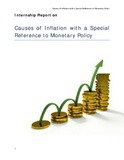| dc.contributor.advisor | Islam, A. B. Mirza Md. Azizul | |
| dc.contributor.author | Tasmia, Maisha | |
| dc.date.accessioned | 2014-06-29T10:00:32Z | |
| dc.date.available | 2014-06-29T10:00:32Z | |
| dc.date.copyright | 2014 | |
| dc.date.issued | 2014-06-29 | |
| dc.identifier.other | ID 10104002 | |
| dc.identifier.uri | http://hdl.handle.net/10361/3371 | |
| dc.description | This internship report is submitted in a partial fulfillment of the requirements for the degree of Bachelor of Business Administration,2014. | en_US |
| dc.description | Cataloged from PDF version of Internship report. | |
| dc.description | Includes bibliographical references (page 39). | |
| dc.description.abstract | Monetary policy is the process by which the monetary authority of a country controls the supply of money, often targeting a rate of interest for the purpose of promoting economic growth and stability. Monetary policy uses a variety of tools to control one or both of these, to influence outcomes like economic growth, inflation, exchange rates with other currencies and unemployment. This paper particularly focuses how a central bank responses while being in an inflationary situation through using monetary policy as a tool and its impact. Monetary policy is referred to as either being expansionary or contractionary, where an expansionary policy increases the total supply of money in the economy more rapidly than usual, and contractionary policy expands the money supply more slowly than usual or even shrinks it. Expansionary policy is traditionally used to try to combat unemployment in a recession by lowering interest rates in the hope that easy credit will entice businesses into expanding. Contractionary policy is intended to slow inflation in order to avoid the resulting distortions and deterioration of asset values. Besides, Monetary policy is used for achieving the objectives of macro-economic management and for providing a sound macro-economic environment which refers to the overall economic measurement of a country with the purpose of achieving a target growth rate of the economy while maintaining price stability, making progress towards poverty alleviation and employment generation and achieving balance of payments viability. Furthermore, this paper also includes an empirical analysis to find out the changes in inflation due to the change the annual money growth rate. However, the findings conclude that, there might remain some dominating other factors along with money supply in the economy to influence the annual inflation rate. | en_US |
| dc.description.statementofresponsibility | Maisha Tasmia | |
| dc.format.extent | 40 pages | |
| dc.language.iso | en | en_US |
| dc.publisher | BRAC University | en_US |
| dc.rights | BRAC University Internship reports are protected by copyright. They may be viewed from this source for any purpose, but reproduction or distribution in any format is prohibited without written permission. | |
| dc.subject | Business administration | en_US |
| dc.title | Causes of inflation with a special reference to monetary policy | en_US |
| dc.type | Internship report | en_US |
| dc.contributor.department | BRAC Business School, BRAC University | |
| dc.description.degree | B. Business Administration | |

